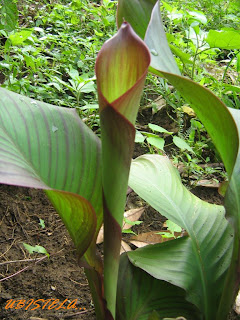 Coconut on the slope...
Coconut on the slope... Pineapple planted when we bought several fruits the other day
Pineapple planted when we bought several fruits the other day Snake Skin fruit (salak madu), the slim and sweet type from Thailand
Snake Skin fruit (salak madu), the slim and sweet type from Thailand Sugar cane from the roadside stall, we saved one bag before they throw it away...
Sugar cane from the roadside stall, we saved one bag before they throw it away...
...MAASYAA ALLAH, LAA QUWWATA ILLAA BILLAH... - Al-Kahfi 18:39. Ubi stela is another name for keledek... There are 2 varieties in the kebun - the orange and purple. Dengan izin Allah yang memberi rezeki, smoga ubi dan tanaman lain berhasil. Dedicated to friends and friends to be who are farmers at heart...
 Coconut on the slope...
Coconut on the slope... Pineapple planted when we bought several fruits the other day
Pineapple planted when we bought several fruits the other day Snake Skin fruit (salak madu), the slim and sweet type from Thailand
Snake Skin fruit (salak madu), the slim and sweet type from Thailand Sugar cane from the roadside stall, we saved one bag before they throw it away...
Sugar cane from the roadside stall, we saved one bag before they throw it away...
 Keladi telur, among the first plant in the farm...
Keladi telur, among the first plant in the farm... Keladi maras (purple) and pinang, I think, (green)
Keladi maras (purple) and pinang, I think, (green)


"Lada Burung" is actually what it is called here. Why's the name? Somebody's theory is that the tree is spread by birds (via its droppings hehehe)

Budu and singgang tongkol anyone?



 "Kulat sisir (edible) - Very common, growing on decaying tree trunk. This one grow on a half burned tree trunk - giving it the dramatic color contrast of black and white.
"Kulat sisir (edible) - Very common, growing on decaying tree trunk. This one grow on a half burned tree trunk - giving it the dramatic color contrast of black and white. The more interesting perspective of the "kulat" where the drama unfolded, where crawlies busy feeding...
The more interesting perspective of the "kulat" where the drama unfolded, where crawlies busy feeding... "Kulat txxx Lembu". The name derived from its favorite growing place i.e. on or around cow dung - not this one though...
"Kulat txxx Lembu". The name derived from its favorite growing place i.e. on or around cow dung - not this one though... "Kulat liat" (edible) - sweet and chewy... Came in 2 variant - white and gray, just like the commercial oyster mushroom.
"Kulat liat" (edible) - sweet and chewy... Came in 2 variant - white and gray, just like the commercial oyster mushroom. Sorry la, can't tell which is which - all look the same... Notice the brinjal in the back ground?
Sorry la, can't tell which is which - all look the same... Notice the brinjal in the back ground? Another unknown tree - be it red or yellow fruit? Only time will tell, kalu panjang umur la, hehehe...
Another unknown tree - be it red or yellow fruit? Only time will tell, kalu panjang umur la, hehehe...

 Berebut-rebut nak tumbuh... Alhamdulillah...
Berebut-rebut nak tumbuh... Alhamdulillah... Now, I too wonder why ah????
Now, I too wonder why ah???? "...lalu Dia menjadikan mereka seperti daun-daun yang dimakan (ulat)." Al-Fiil 105:5.
"...lalu Dia menjadikan mereka seperti daun-daun yang dimakan (ulat)." Al-Fiil 105:5.  ...but one!
...but one! Don't mistaken the sawi for other thing ya...
Don't mistaken the sawi for other thing ya... Must be "finger licking good" ah?!! hahahah
Must be "finger licking good" ah?!! hahahah
 Trying to conserve the almost extict plant and revive the fond memories of yesteryears - Nora the traditionalist
Trying to conserve the almost extict plant and revive the fond memories of yesteryears - Nora the traditionalist From a different perspective. Subhanallah! God's signature - too beautiful not to share with others - Nora the artist.... hehehe
From a different perspective. Subhanallah! God's signature - too beautiful not to share with others - Nora the artist.... hehehe Rumput Seranek - common in the swamp. Very difficult to get rid of - unless if we used weed killer... But I am determined to keep the farm organic, so let it be la...
Rumput Seranek - common in the swamp. Very difficult to get rid of - unless if we used weed killer... But I am determined to keep the farm organic, so let it be la... As I spy with my 2 little eyes... Can you find the kangkong in the midst? Hahaha Remember the song "tinggi lah rumput dari padi"
As I spy with my 2 little eyes... Can you find the kangkong in the midst? Hahaha Remember the song "tinggi lah rumput dari padi" The more successful shot... The actual size of this kelulut flower is about the size of 5 sen coin. Btw, kumbang tu tak gi skolah, gi tunjuk tut...tut... plak - kalu nak posing biarlah btul2 hahahaha....
The more successful shot... The actual size of this kelulut flower is about the size of 5 sen coin. Btw, kumbang tu tak gi skolah, gi tunjuk tut...tut... plak - kalu nak posing biarlah btul2 hahahaha.... ...posing betul2 like this one.
...posing betul2 like this one.  Mak Teh took the honour to plant the first Raja Kunyit to commemorate her visit to the farm
Mak Teh took the honour to plant the first Raja Kunyit to commemorate her visit to the farm ...and Pak Teh, likewise
...and Pak Teh, likewise The 101 type
The 101 type The 101's batch of new leaves - looks like gold eh? Aptly hailed as King of Fruits...
The 101's batch of new leaves - looks like gold eh? Aptly hailed as King of Fruits... Bila nak besar ni Mak Teh oi?...
Bila nak besar ni Mak Teh oi?...